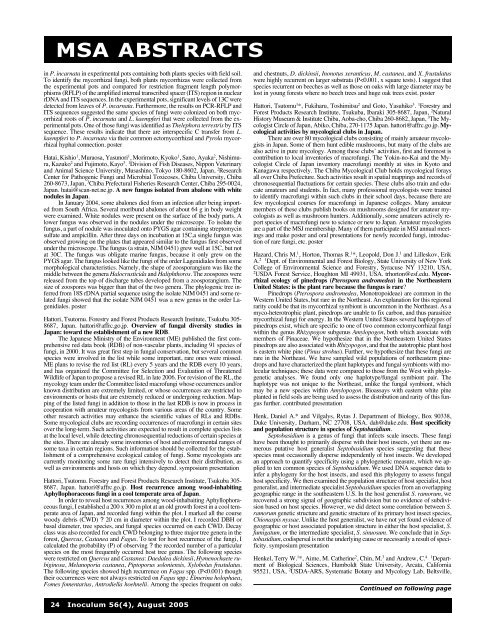Inoculum 56(4) - Mycological Society of America
Inoculum 56(4) - Mycological Society of America
Inoculum 56(4) - Mycological Society of America
You also want an ePaper? Increase the reach of your titles
YUMPU automatically turns print PDFs into web optimized ePapers that Google loves.
MSA ABSTRACTS<br />
in P. incarnata in experimental pots containing both plants species with field soil.<br />
To identify the mycorrhizal fungi, both plants mycorrhizas were collected from<br />
the experimental pots and compared for restriction fragment length polymorphisms<br />
(RFLP) <strong>of</strong> the amplified internal transcribed spacer (ITS) region in nuclear<br />
rDNA and ITS sequences. In the experimental pots, significant levels <strong>of</strong> 13C were<br />
detected from leaves <strong>of</strong> P. incarnata. Furthermore, the results on PCR-RFLP and<br />
ITS sequences suggested the same species <strong>of</strong> fungi were colonized on both mycorrhizal<br />
roots <strong>of</strong> P. incarnata and L. kaempferi that were collected from the experimental<br />
pots. One <strong>of</strong> those fungi was identified as Thelephora terrestris by ITS<br />
sequence. These results indicate that there are interspecific C transfer from L.<br />
kaempferi to P. incarnata via their common ectomycorrhizal and Pyrola mycorrhizal<br />
hyphal connection. poster<br />
Hatai, Kishio 1 , Muraosa, Yasunori 1 , Morimoto, Kyoko 1 , Sano, Ayaka 2 , Nishimura,<br />
Kazuko 2 and Fujimoto, Kayo 3 . 1 Division <strong>of</strong> Fish Diseases, Nippon Veterinary<br />
and Animal Science University, Musashino, Tokyo 180-8602, Japan, 2 Research<br />
Center for Pathogenic Fungi and Microbial Toxicoses, Chiba University, Chiba<br />
260-8673, Japan, 3 Chiba Prefectural Fisheries Research Center, Chiba 295-0024,<br />
Japan. hatai@scan-net.ne.jp. A new fungus isolated from abalone with white<br />
nodules in Japan.<br />
In January 2004, some abalones died from an infection after being imported<br />
from South Africa. Several moribund abalones <strong>of</strong> about 64 g in body weight<br />
were examined. White nodules were present on the surface <strong>of</strong> the body parts. A<br />
lower fungus was observed in the nodules under the microscope. To isolate the<br />
fungus, a part <strong>of</strong> nodule was inoculated onto PYGS agar containing streptomycin<br />
sulfate and ampicillin. After three days on incubation at 15C,a single fungus was<br />
observed growing on the plates that appeared similar to the fungus first observed<br />
under the microscope. The fungus (a strain, NJM 0451) grew well at 15C, but not<br />
at 30C. The fungus was obligate marine fungus, because it only grew on the<br />
PYGS agar. The fungus looked like the fungi <strong>of</strong> the order Lagenidiales from some<br />
morphological characteristics. Namely, the shape <strong>of</strong> zoosporangium was like the<br />
middle between the genera Halocrusticida and Haliphthoros. The zoospores were<br />
released from the top <strong>of</strong> discharge tubes developed from a zoosporangium. The<br />
size <strong>of</strong> zoospores was bigger than that <strong>of</strong> the two genera. The phylogenic tree inferred<br />
from 18S rDNA partial sequence using the isolate NJM 0451 and some related<br />
fungi showed that the isolate NJM 0451 was a new genus in the order Lagenidiales.<br />
poster<br />
Hattori, Tsutomu. Forestry and Forest Products Research Institute, Tsukuba 305-<br />
8687, Japan. hattori@affrc.go.jp. Overview <strong>of</strong> fungal diversity studies in<br />
Japan: toward the establishment <strong>of</strong> a new RDB.<br />
The Japanese Ministry <strong>of</strong> the Environment (ME) published the first comprehensive<br />
red data book (RDB) <strong>of</strong> non-vascular plants, including 91 species <strong>of</strong><br />
fungi, in 2000. It was great first step in fungal conservation, but several common<br />
species were involved in the list while some important, rare ones were missed.<br />
ME plans to revise the red list (RL) every 5 years and the RDB every 10 years,<br />
and has organized the Committee for Selection and Evaluation <strong>of</strong> Threatened<br />
Wildlife <strong>of</strong> Japan to propose a revised RL in late 2006. For revision <strong>of</strong> the RL, the<br />
mycology team under the Committee listed macr<strong>of</strong>ungi whose occurrences and/or<br />
known distribution are extremely limited, or whose occurrences are restricted to<br />
environments or hosts that are extremely reduced or undergoing reduction. Mapping<br />
<strong>of</strong> the listed fungi in addition to those in the last RDB is now in process in<br />
cooperation with amateur mycologists from various areas <strong>of</strong> the country. Some<br />
other research activities may enhance the scientific values <strong>of</strong> RLs and RDBs.<br />
Some mycological clubs are recording occurrences <strong>of</strong> macr<strong>of</strong>ungi in certain sites<br />
over the long-term. Such activities are expected to result in complete species lists<br />
at the local level, while detecting chronosequential reductions <strong>of</strong> certain species at<br />
the sites. There are already some inventories <strong>of</strong> host and environmental ranges <strong>of</strong><br />
some taxa in certain regions. Such information should be collected for the establishment<br />
<strong>of</strong> a comprehensive ecological catalog <strong>of</strong> fungi. Some mycologists are<br />
currently monitoring some rare fungi intensively to detect their distribution, as<br />
well as environments and hosts on which they depend. symposium presentation<br />
Hattori, Tsutomu. Forestry and Forest Products Research Institute, Tsukuba 305-<br />
8687, Japan. hattori@affrc.go.jp. Host recurrence among wood-inhabiting<br />
Aphyllophoraceous fungi in a cool temperate area <strong>of</strong> Japan.<br />
In order to reveal host recurrences among wood-inhabaiting Aphyllophoraceous<br />
fungi, I established a 200 x 300 m plot at an old growth forest in a cool temperate<br />
area <strong>of</strong> Japan, and recorded fungi within the plot. I marked all the course<br />
woody debris (CWD) ? 20 cm in diameter within the plot. I recorded DBH or<br />
basal diameter, tree species, and fungal species occurred on each CWD. Decay<br />
class was also recorded for each CWD belonging to three major tree genera in the<br />
forest, Quercus, Castanea and Fagus. To test for host recurrence <strong>of</strong> the fungi, I<br />
calculated the probability (P) <strong>of</strong> observing ? the recorded number <strong>of</strong> a particular<br />
species on the most frequently occurred host tree genus. The following species<br />
were restricted on Quercus and Castanea: Daedalea dickinsii, Hymenochaete rubiginosa,<br />
Melanoporia castanea, Piptoporus soloniensis, Xylobolus frustulatus.<br />
The following species showed high recurrence on Fagus spp. (P

















